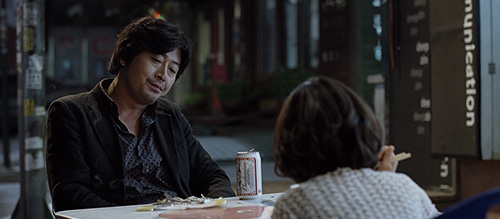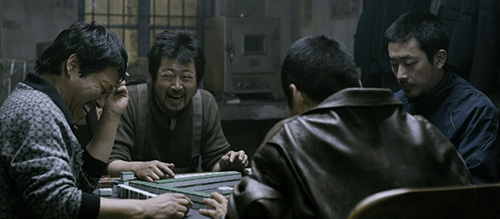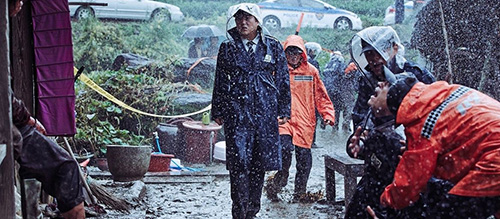Director Spotlight: Na Hong-Jin
A few years ago I had the pleasure of seeing The Wailing at Abertoir Festival 2016 and it blew me away. After picking it up on DVD not long after, it soon became one of my favourite films of all time. Upon discovering that its director, Na Hong-Jin, had only directed three feature films, I decided to buckle down with a notepad and pen and see what I could learn about the Seoul-born filmmaker’s techniques and motifs.
Overview
These are the films and a quick list of corresponding points of note, such as filming style, cinematography, theme, motifs, etc, which will be explored in full below.
The Chaser (2008): Muted colour palettes/ unstable camera movement/ urbanity and violence/ parent-child bonds/ rain as emotion (pathetic fallacy).
The Yellow Sea (2008): Muted colour palettes/ unstable camera movement/ urbanity and violence/ parent-child bonds/ racial tensions.
The Wailing (2016): Green-heavy colour palette/ smooth camera movement/ rurality and mythology/ parent-child bonds/ rain as emotion (pathetic fallacy)/ racial tensions.
The Chaser (2008)
A violent crime thriller set in Seoul, a retired cop running a prostitution ring has to track down two missing girls and prevent others from meeting a similar fate. It is a breathtaking piece of filmmaking with harrowing torture scenes, thrilling chases and fights, and some black comedy sprinkled into the mix. It’s the perfect example of why Korean blockbusters work so well.
One of the first things that struck me about The Chaser was the carefully chosen colour palette. A mix of dull, muted greys and browns are interspersed with the city’s dazzling red light. Most of the interior sets also have the same, bland look about them, with very little colour if any at all. Psychologically, this interestingly sets up the antagonist’s home, which is full of deep, rich wooden panels, with bright blue lights of the fish tank as all the more luxurious due to its stark contrast to the city’s bleaker tones. Additionally, the house is set against vibrant greens of trees and grass, something missing from almost any other part of the film.
And yet, in the bathroom, where torture scenes take place, it is pale and grimy, interspersed with flecks of red much like the colour palette of Seoul. I put forth to you the idea that the specific use of colour in the film helps suggest that urbanity leads to violence, infecting even attempted rurality. We will see the colour palette become important again, especially in regards to The Yellow Sea, as these two films are the closest in tone and style.
Hong-Jin’s use of camera movement is also interesting to analyse. Very rarely is the camera unmoving. Most of the time when it’s not panning or tracking, it’s off the tripod entirely. Only in very specific moments is the movement smooth. Tracking shots will usually only occur when a character is moving with purpose, for example. Hong-Jin is using the style to match the gritty treatment of the characters and the feel of the story. If the camera is stable and stationary, such as the night to day transition of a parked car near the start of the film, he wants you to notice it. This helps establish specific camera movements almost in a similar fashion to a leitmotif, (a leitmotif is a musical term, where a short phrase of music is played to denote a character, theme or place. Howard Shore’s score to Peter Jackson’s The Lord Of The Rings trilogy (2001-2003) is a perfect example, and I would suggest watching a great series of videos by YouTube channel Inside The Score, on how leitmotifs work in regards to those films). When the tracking is smooth, you should feel that the character being followed is determined, and eventually it becomes almost Pavlovian. When you experience that camera movement, you feel a certain way. For a first-time feature film director, this is a very purposeful approach indicative of a more grand vision.
Several other elements also come into play in the film, such as the use of rain. Significantly, one of the instances of heavy rain comes after the protagonist learns of the death of a child’s mother (who is there with him in the car – which is also grey and drab), the rain used to match her tears. Here the rain is the primary signifier of the grief the child experiences, and it is this grief, in this moment, that underscores the emotion for the entire film. Blackly comedic in many respects, I believe that it is this moment which adds the emotional weight to the film. These are real people, and they are really dying, and that has devastating emotional impacts on the other characters.
I mention this because the role of father, or father-figure in this case, is also a main theme running through Hong-Jin’s work, and rain here, combined with Jeong-ho’s presence nearby, highlights the chaos caused by the fracturing of the family unit. For a moment, a daughter is all alone in the world of bland streets and uncaring violence. When later on, Jeong-ho abandons the umbrella in preparation for the final fight, he has embraced the girl’s grief, and used it to fuel him onward. This is now a revenge mission, a quest for vengeance against the destruction of parent-child relations, and an attempt to rebuild that unit in the harshest of environments, whatever the cost.
The Yellow Sea (2010)
Another violent thriller, this film follows a man tasked with travelling back from China to Korea to assassinate a professor, before having to run for his life after unexpected events botch the job. Perhaps the most similar to a stereotypical western crime thriller, The Yellow Sea carries across numerous concepts and motifs from The Chaser, and doubles down on the directorial style that has already been established.
The first thing to notice is that there are even less stable shots throughout this film. Almost all the shots are handheld, with some tracks reserved for determined movement and action sequences. The final shot of the film, when all is calm and finished, is perhaps the only true stationary shot of the film. The style here presents a rough look for a rough film steeped in conflicts of wealth and poverty that focuses in on the poorest of society and its locations.
What should not be underestimated in this film are the racial tensions that go on between China and Korea. Gu-nam, our protagonist, is insulted various times for being Korean whilst at the Mah-jong hall, and after arriving in Seoul there are several instances when he must maintain that he is Korean to the locals. A sequence of Gu-nam being smuggled across the border is harrowing and claustrophobic, and only aids the ever-building tension. He is a stranger not only in China, but also in Korea, his homeland. He is dislocated with nowhere to go, down and out, with only his drive to try and do what is right, to keep him going. There are not only antagonisms toward what he has done and is doing from various violent factions, but also who he fundamentally is.
This particular Hong-Jin entry is so grey and washed out that it’s easy to think that the only colour on screen comes from the presentation of blood. The dust of the roads and the sandy bark of the dead trees in winter present us a bleak world similar to The Chaser, only this time even more so. Sometimes there are whole sections of the film where the colour green isn’t visible even for a second. It feels like a world in which the city from Seven (1995) could easily be dropped into, though perhaps with slightly less rain. The world around him is dead, grey and ashen, and mirrors Gu-nam’s predicament; alone, surrounded only by those that want him caught or dead.
And yet, speaking of rain, in The Yellow Sea the rain is transfigured into the yellow sea itself. At the end of the movie where, overcome and done with life and his task, Gu-nam is laid to rest, thrown overboard into the sea. Here the water washes away his sins, just as the shower does in Psycho (1960). Also, after a moment in which he breaks down in tears in the dead woods of the mountains, he hikes his way back to the city and finds it at night, with a damp mist surrounding him. Here the mist not only stands in for the rain, but subtly adds to the gloomy, oppressive atmosphere of the Korea Hong-Jin is depicting in the film.
There are also times when children are a focal point just like in The Chaser, the most important being that Gu-nam takes on the job because he is trying to clear off his debt and return home to his child, who has had to sit in the middle of a messy breakup between his parents. The care of children, and the maintaining of the family unit, despite all the hardships and consequences that come with its maintenance, is central to Hong-Jin’s work, and is perhaps the main hook to hang his emotional resonance with the audience. It is so strong a theme, in fact, that it becomes the central driving force behind his most recent work, The Wailing.
The Wailing (2016)
Hong-Jin steps away from crime thrillers and into supernatural horror with a film that is so remarkably different from his other work that it’s sometimes hard to tell if it was by the same filmmaker.
In the rural town of Gokseong, a small-town cop must investigate a string of murders and claims of a demon in the hills, whereupon he unknowingly unleashes a supernatural evil that takes possession of his daughter.
Soaked in the wet foliage of the hills, The Wailing takes on a completely different tone and style, one that is marked most prominently by the change in camera philosophy. Whereas in The Yellow Sea the film is almost completely handheld, here the usage is primarily mounted and stable, with establishing shots punctuated by a subtle, slow push-in to add to the voyeuristic creepiness. It is similar to the style of Stanley Kubrick in The Shining (1980); trading in the halls of the Overlook for the hills of Gokseong. It is slow, away from the chaos of the city as shown in the previous two films, and into the brooding menace of rurality, where horror has lain dormant and patient for centuries. More than just where to film, Hong-Jin knows how to film, something that even the very best filmmakers often get wrong.
It is not only the shooting style that changes. The sudden drenching of the screen in the lush green hills of rural Korea changes the colour palette entirely from The Yellow Sea and The Chaser. The film is less washed out, more vibrant, deep in the heart of spirituality and mythology (as depicted by no less than three different spiritual powers). The man-made violence of the city has been left far behind, and here we have the threat coming from the hills dressed in human flesh. Punctuating the green of the hills and the grey and dark blue/black of the sky, the ritual fires and streetlamps make the orange glow a somewhat primal talisman. Beasts don’t like fire, and so we as an audience, along with the characters themselves, need to gather around it to protect ourselves and our families.
The film’s central concern, however, is the continued exploration of a father’s relationship with his children. In The Wailing, Hong-Jin directly attacks the family unit through demonic possession, with Jong-Goo’s daughter, Hyo-Jin, creating the nexus for the influences of three embodied spirits and forces. Jong-goo can be read as to have been dismissive and forgetful about Hyo-Jin at the start of the film. He is unenthusiastic about a charm she buys in the shop, for example, but he nonetheless becomes the stronger father figure throughout the film once the terror sets in. The strengthened bond is therefore similar to that of the surrogate father/daughter relationship in The Chaser, a tag-along child becoming instrumental to the character’s motivation to catch the criminal.
We also see a return of the suspicion of the foreigner in the paranoia surrounding a Japanese tourist. The appearance of the stranger and the immediate shadow of doubt cast over him in relation to the murders are noticeable because his nationality is frequently mentioned. He is not simply ‘the stranger’, but the Japanese stranger, his defining trait being his nationality. If he is suspected, it is primarily because he is not Korean. The tribal instincts of the locals are at play here as they are in countless Universal monster movie, with the distrust of the monstrous ‘other’ for racial reasons being a primary motivator in the group suspicions.
Conclusion
In his films, Na Hong-Jin gives a masterclass of colour, camera, and theme, which weave together harmoniously to create rich, engaging worlds despite location or genre. His focus on the family unit, specifically the father/daughter relationship, is the key concept in his work, and the maintaining of family as a traditional unit is a core theme in his films. His use of dreary landscapes, punctuated by orange streetlights or fires, around which people huddle, presents us with a tribal image of a family huddled around a campfire, violence and mayhem occurring all around them. The threat of urbanity and the corruption of the natural world present us with a somewhat romantic view of things. Hong-Jin wants us to band together in the dark times, as a family group, and endure the violence.
Article by Kieran Judge
Bibliography
Psycho. 1960. [Film] Directed by Alfred Hitchcock. United States of America: Shamley Productions.
Score, I. T., 2017. Lord of the Rings: How Howard Shore Created a Masterpiece (1 of 3). [Online]
Available at: https://www.youtube.com/watch?v=-Deesm_fadg
[Accessed 01 12 2018].
Seven. 1995. [Film] Directed by David Fincher. United States of America: New Line Cinema.
The Chaser. 2008. [Film] Directed by Na Hong-Jin. South Korea: Big House.
The Shining. 1980. [Film] Directed by Stanley Kubrick. United States of America: Warner Brothers.
The Wailing. 2016. [Film] Directed by Na Hong-Jin. South Korea: Side Mirror.
The Yellow Sea. 2010. [Film] Directed by Na Hong-Jin. South Korea: Showbox.
[DISPLAY_ULTIMATE_SOCIAL_ICONS]




